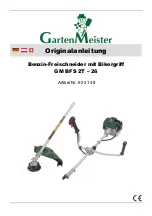
9 ENGLISH
5.
To check lower guard, open lower guard by
hand, then release and watch guard closure.
Also check to see that retracting handle does
not touch tool housing.
Leaving blade exposed
is VERY DANGEROUS and can lead to serious
personal
injury.
Additional safety warnings
1.
Do not stop the blades by lateral pressure on
the saw blade.
2.
DANGER:
Do not attempt to remove cut material when
blade is moving.
CAUTION: Blades coast after turn off.
3.
Place the wider portion of the saw base on
that part of the workpiece which is solidly
supported, not on the section that will fall off
when the cut is made. If the workpiece is
short or small, clamp it down. DO NOT TRY
TO HOLD SHORT PIECES BY HAND!
4.
Never attempt to make a cut with the tool held
upside down in a vise. This is extremely
dangerous and can lead to serious accidents.
5.
Wear safety goggles and hearing protection
during operation.
6.
Do not use any abrasive wheels.
7.
Only use the saw blade with the diameter that
is marked on the tool or specified in the
manual.
Use
of
an
incorrectly sized
blade
may
affect
the proper guarding of the blade
or guard operation
which
could
result
in
serious
personal
injury.
8.
Always use the saw blade intended for cutting
the material that you are going to cut.
9.
Only use the saw blades that are marked with
a speed equal or higher than the speed
marked on the tool.
SAVE THESE INSTRUCTIONS.
WARNING:
DO NOT let comfort or familiarity
with product (gained from repeated use) replace
strict adherence to safety rules for the subject
product. MISUSE or failure to follow the safety
rules stated in this instruction manual may cause
serious personal injury.
Important safety instructions for
battery cartridge
1.
Before using battery cartridge, read all
instructions and cautionary markings on (1)
battery charger, (2) battery, and (3) product
using battery.
2.
Do not disassemble battery cartridge.
3.
If operating time has become excessively
shorter, stop operating immediately. It may
result in a risk of overheating, possible burns
and even an explosion.
4.
If electrolyte gets into your eyes, rinse them
out with clear water and seek medical
attention right away. It may result in loss of
your eyesight.
5.
Do not short the battery cartridge:
(1)
Do not touch the terminals with any
conductive material.
(2)
Avoid storing battery cartridge in a
container with other metal objects such
as nails, coins, etc.
(3)
Do not expose battery cartridge to water
or rain.
A battery short can cause a large current
flow, overheating, possible burns and even a
breakdown.
6.
Do not store the tool and battery cartridge in
locations where the temperature may reach or
exceed 50 °C (122 °F).
7.
Do not incinerate the battery cartridge even if
it is severely damaged or is completely worn
out. The battery cartridge can explode in a
fire.
8.
Be careful not to drop or strike battery.
9.
Do not use a damaged battery.
10.
The contained lithium-ion batteries are
subject to the Dangerous Goods Legislation
requirements.
For commercial
transports e.g.
by
third
parties,
forwarding agents, special requirement on
packaging and labeling must be observed. For
preparation of the item being shipped, consulting
an
expert
for
hazardous material
is
required.
Please
also
observe
possibly
more
detailed
national regulations.
Tape or mask off open contacts and pack up the
battery
in
such
a
manner
that
it
cannot
move
around in the packaging.
11.
Follow your local regulations relating to
disposal of battery.
12.
Use the batteries only with the products
specified by Makita.
Installing the batteries to
non-compliant
products
may
result
in
a
fire,
excessive heat,
explosion, or
leak
of
electrolyte.
SAVE THESE INSTRUCTIONS.
Summary of Contents for DCS553
Page 1: ......
Page 2: ...2 ...
Page 3: ...3 Fig 11 ...
Page 4: ...4 Fig 15 Fig 16 4 5 ...
Page 5: ...5 Fig 20 ...
Page 136: ...885652A993 ...
Page 137: ...Anjo Aichi 446 8502 Japan www makita com EN FR DE IT NL ES PT DA EL TR 20180323 ...










































